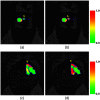Quantitative identification of magnetic resonance imaging features of prostate cancer response following laser ablation and radical prostatectomy
- PMID: 26158070
- PMCID: PMC4478957
- DOI: 10.1117/1.JMI.1.3.035001
Quantitative identification of magnetic resonance imaging features of prostate cancer response following laser ablation and radical prostatectomy
Abstract
Laser interstitial thermotherapy (LITT) is a relatively new focal therapy technique for the ablation of localized prostate cancer. In this study, for the first time, we are integrating ex vivo pathology and magnetic resonance imaging (MRI) to assess the imaging characteristics of prostate cancer and treatment changes following LITT. Via a unique clinical trial, which gave us the availability of ex vivo histology and pre- and post-LITT MRIs, (1) we investigated the imaging characteristics of treatment effects and residual disease, and (2) evaluated treatment-induced feature changes in the ablated area relative to the residual disease. First, a pathologist annotated the ablated area and the residual disease on the ex vivo histology. Subsequently, we transferred the annotations to the post-LITT MRI using a semi-automatic elastic registration. The pre- and post-LITT MRIs were registered and features were extracted. A scoring metric based on the change in median pre- and post-LITT feature values was introduced, which allowed us to identify the most treatment responsive features. Our results show that (1) image characteristics for treatment effects and residual disease are different, and (2) the change of feature values between pre- and post-LITT MRIs can be a quantitative biomarker for treatment response. Finally, using feature change improved discrimination between the residual disease and treatment effects.
Keywords: laser ablation therapy; magnetic resonance imaging; prostate cancer; treatment response.
Figures







References
-
- Hegarty J., et al. , “Radical prostatectomy versus watchful waiting for prostate cancer,” Cochrane Database Syst. Rev. (11), CD006590 (2010). - PubMed
Grants and funding
LinkOut - more resources
Full Text Sources
Other Literature Sources

